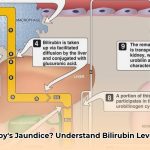Is your newborn’s skin or eyes appearing yellowish? This is likely jaundice, a common condition in newborns. This comprehensive guide explains newborn jaundice, bilirubin screening, and the 2022 AAP guidelines (American Academy of Pediatrics) in easy-to-understand language, empowering you to advocate for your baby’s health and understand when to seek medical attention. For more detailed information on interpreting your baby’s jaundice results, see this helpful resource: jaundice results.
Understanding Bilirubin and Newborn Jaundice
As a new parent, you’re faced with many new health concerns for your baby, including jaundice. Knowing about bilirubin, the substance that causes jaundice, can help ease your worries and ensure the best care for your little one. Jaundice causes a yellowish color in the skin and eyes of newborns. But, what actionable steps can you take to effectively monitor your baby’s health?
What is Bilirubin?
Bilirubin is produced when the body breaks down old red blood cells. A newborn’s liver, which is still developing, might not be able to process bilirubin efficiently. This causes a buildup of bilirubin, resulting in jaundice. In most cases, jaundice is harmless and goes away on its own within a week or two. However, in some instances, high bilirubin levels can be a cause for concern, requiring medical treatment. How can you tell the difference between harmless and concerning jaundice?
Why is Bilirubin Screening Important?
Most cases of jaundice are not serious, but high bilirubin levels, if not treated, can, in rare circumstances, lead to kernicterus, a type of brain damage. This is why regular bilirubin checks are essential soon after birth. Early detection enables doctors to intervene and prevent potential problems related to severe hyperbilirubinemia (high bilirubin levels in the blood).
When and How are Bilirubin Levels Checked?
Typically, your baby’s bilirubin level will be checked within the first few days of life, often before you leave the hospital. The most common method is a transcutaneous bilirubin (TcB) measurement. This is a quick, painless procedure where a device is placed on your baby’s skin to measure bilirubin levels without drawing blood. In some cases, a blood sample may be needed for a total serum bilirubin (TSB) test, especially if the TcB reading is high or jaundice is visibly pronounced. What specific questions should you ask your pediatrician about bilirubin screening?
Understanding Bilirubin Levels and the 2022 AAP Guidelines
The American Academy of Pediatrics (AAP) has published updated guidelines for managing jaundice in newborns. These guidelines help doctors determine if treatment is necessary, and take into account things like your baby’s age, gestational age (prematurity), overall health, and bilirubin levels. Because every baby is different, the levels that trigger action will vary. Your doctor will explain the test results and recommend the best course of action for your baby.
Factors That Can Influence Bilirubin Levels
Consider the following factors when talking with your doctor about your baby’s care:
- Gestational Age: Premature babies are more likely to have jaundice because their livers aren’t fully developed.
- Ethnicity: Some ethnic groups are more prone to jaundice due to genetic factors.
- Family History: Jaundice can run in families.
- Breastfeeding: Breastfed babies sometimes have higher bilirubin levels, especially in the first week. This can be due to lower fluid intake initially, but usually resolves with frequent feedings and proper milk intake.
- Blood Type Incompatibility: If the mother and baby have different blood types, it can lead to increased bilirubin levels.
- Underlying Health Issues: Infections or blood disorders can affect bilirubin levels.
- G6PD Deficiency: Glucose-6-phosphate dehydrogenase (G6PD) deficiency is a genetic condition that can increase the risk of jaundice.
This information is for educational purposes only and should not replace medical advice. Always talk to your doctor if you have any concerns about your baby’s health.
What Happens if Bilirubin Levels are High?
If your baby’s bilirubin levels are high, the doctor will likely recommend treatment, typically phototherapy (light therapy). Phototherapy helps break down bilirubin in your baby’s blood. The treatment is usually very effective. In rare cases, more intensive treatments, such as blood transfusions, may be necessary, but this is uncommon.
Your Role: Active Participation
As your baby’s parent, you play a crucial role in their care. Make sure to attend all scheduled checkups and don’t hesitate to ask questions. It’s normal to feel worried, so trust your instincts and bring any concerns to your doctor’s attention. What resources can you use to prepare for discussions with your pediatrician? Early detection and treatment are key.
Understanding Phototherapy
Think of your baby’s liver as a tiny factory that processes bilirubin. Sometimes, it needs extra help. Phototherapy provides additional “equipment” in the form of special lights to speed up the process.
Simplified Risk Factors and Bilirubin Levels
| Risk Factor | Low Risk | Moderate Risk | High Risk |
|---|---|---|---|
| Bilirubin Level (mg/dL) | Below threshold (as determined by doctor) | Near threshold | Significantly above threshold |
| Gestational Age (weeks) | ≥38 | 35-37 | <35 |
| Other Factors | None | Minor issues, well-appearing | Multiple concerning symptoms, ill-appearing |
| Hemolytic Disease (Blood Group Incompatibility, etc.) | Absent | Possible, further investigation needed | Present |
| G6PD Deficiency | Absent | Family history or unknown status | Confirmed presence |
This table is a simplified overview and should not be used to make medical decisions. Always consult with your healthcare provider.
This guide provides general information and should not be substituted for professional medical advice. Always discuss your baby’s care with their doctor or healthcare provider.
How to Implement the 2022 AAP Neonatal Hyperbilirubinemia Guidelines
It’s understandable to feel anxious about your newborn’s health. The 2022 American Academy of Pediatrics (AAP) guidelines offer updated recommendations on managing hyperbilirubinemia (high bilirubin levels) in newborns. Let’s examine how to effectively use these guidelines to promote your baby’s well-being. The 2022 AAP guidelines refine thresholds for treatment based on new research and evidence.
The Importance of Early Screening
The 2022 AAP guidelines emphasize early detection through universal screening. Your baby’s bilirubin levels will be checked before leaving the hospital. This crucial initial screening is typically done with a simple, non-invasive skin test or a blood test.
Implementing the 2022 AAP Guidelines: Key Steps
Following the 2022 AAP guidelines involves these key steps:
- Identify Risk Factors: Certain factors increase the risk of high bilirubin, including prematurity, blood type incompatibility (Rh or ABO), G6PD deficiency, bruising during birth, and a family history of jaundice requiring treatment. Discuss your baby’s individual risk profile with your pediatrician.
- Monitor Bilirubin Levels: Your doctor will monitor bilirubin levels using a transcutaneous bilirubinometer (TcB) or a total serum bilirubin (TSB) blood test, following the recommended schedule. If using TcB, be aware of the limitations and when a TSB might be necessary.
- Assess Neurotoxicity Risk Factors: The guidelines emphasize identifying neurotoxicity risk factors such as isoimmune hemolytic disease, G6PD deficiency, asphyxia, sepsis, acidosis, or albumin <3 g/dL, as these factors influence treatment thresholds.
- Implement Treatment Based on Thresholds: The AAP guidelines provide specific phototherapy and exchange transfusion thresholds based on gestational age, bilirubin level, and the presence or absence of neurotoxicity risk factors. Your doctor will use these guidelines to determine the appropriate treatment.
- Provide Breastfeeding Support: Breastfeeding is highly encouraged. Seek support from lactation consultants to ensure the baby receives adequate nutrition. Effective breastfeeding is crucial for reducing the risk of jaundice.
- Differentiate Breastfeeding Jaundice from Breast Milk Jaundice: The 2022 guidelines highlight the importance of distinguishing between these two types of jaundice, as their management differs. Breastfeeding jaundice typically occurs in the first week due to insufficient milk intake, while breast milk jaundice appears later and may be related to factors in breast milk that affect bilirubin metabolism.
- Plan Post-Discharge Follow-Up: Ensure appropriate follow-up after hospital discharge to monitor bilirubin levels, especially for babies discharged early or those with risk factors for jaundice.
- Open Communication: Maintain open communication with your pediatrician or neonatologist regarding any concerns.
Addressing Parental Concerns
It’s natural to feel worried and overwhelmed. Know that jaundice is common and often easily treated. Early detection, close monitoring, and open communication with your healthcare provider are essential.
Key Takeaways:
- Early detection of jaundice is critical through universal screening.
- The 2022 AAP guidelines offer refined and evidence-based treatment thresholds.
- Phototherapy is a safe and effective treatment for high bilirubin levels.
*
- Wind Turbine Fire: Questions About Safety Spark Debate - October 31, 2025
- Vertical Axis Wind Turbine Design: Improving Efficiency and Overcoming Limits - October 29, 2025
- Wind Turbine to Power Home: Nacelle Design Improvements Advance - October 26, 2025















